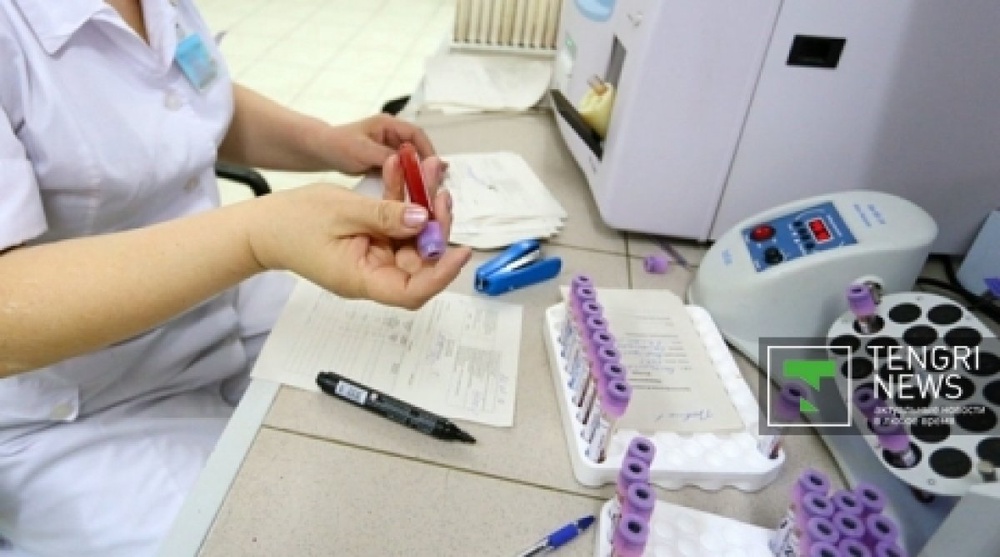
The Astana blood bank has collected around 700 samples of stem cells from umbilical blood and placenta, Tengrinews reports. The stem cells bank, a part of the Astana blood bank, was opened in 2009. The scientists collect and process blood from umbilical veins and placenta. Then, they extract a concentrate of hematopoietic stem cells and freeze it at -196C degrees. Stem cells can be stored for 20 years in these conditions. The collection and storage of samples is done free of charge. In future, the stem cells can be used to cure blood disorders. Stem cells transplantation helps patients with cancer, atrophic anemia and those recovering from chemotherapy. Scientists plan to use stem cell technology to cure various endocrine, neurodystrophic and cardiac illnesses. Compatibility of the recipient’s genotype with the donor stem cells is the key. Unfortunately, not everyone can donate umbilical blood. “There are a number of general contraindications (relevant to blood donors) and some contraindications connected with pregnancy and childbirth. That is why not every pregnant woman can be an umbilical blood donor,” a representative of a blood bank said. The process of hematopoietic stem cells extraction is complex and not all donated blood has hematopoietic stem cells of a high enough quality and not all collected samples are usable, the blood bank scientists say. Earlier, the Head of the Family Medicine Center Ivan Korkan talked with a Tengrinews reporter about the future for stem cell research in Kazakhstan. “What's interesting is that with cell technologies it is possible to grow a new organ inside a human body. Today in Japan, thanks to stem cells, 8 people out of 10 who require a heart transplant are cured without a transplantation surgery,” Dr. Korkan said. Considering the level of scientific research in this area, Dr. Korkan believes that “there is no point in spending tons of money" developing our own technologies "when there are no results”. “It does not matter if we are the first, the second or the third to use a technology. We just have to “keep out finger on the pulse”,” Dr. Korkan said.





The Astana blood bank has collected around 700 samples of stem cells from umbilical blood and placenta, Tengrinews reports.
The stem cells bank, a part of the Astana blood bank, was opened in 2009. The scientists collect and process blood from umbilical veins and placenta. Then, they extract a concentrate of hematopoietic stem cells and freeze it at -196C degrees. Stem cells can be stored for 20 years in these conditions. The collection and storage of samples is done free of charge.
In future, the stem cells can be used to cure blood disorders. Stem cells transplantation helps patients with cancer, atrophic anemia and those recovering from chemotherapy. Scientists plan to use stem cell technology to cure various endocrine, neurodystrophic and cardiac illnesses. Compatibility of the recipient’s genotype with the donor stem cells is the key.
Unfortunately, not everyone can donate umbilical blood. “There are a number of general contraindications (relevant to blood donors) and some contraindications connected with pregnancy and childbirth. That is why not every pregnant woman can be an umbilical blood donor,” a representative of a blood bank said.
The process of hematopoietic stem cells extraction is complex and not all donated blood has hematopoietic stem cells of a high enough quality and not all collected samples are usable, the blood bank scientists say.
Earlier, the Head of the Family Medicine Center Ivan Korkan talked with a Tengrinews reporter about the future for stem cell research in Kazakhstan.
“What's interesting is that with cell technologies it is possible to grow a new organ inside a human body. Today in Japan, thanks to stem cells, 8 people out of 10 who require a heart transplant are cured without a transplantation surgery,” Dr. Korkan said.
Considering the level of scientific research in this area, Dr. Korkan believes that “there is no point in spending tons of money" developing our own technologies "when there are no results”. “It does not matter if we are the first, the second or the third to use a technology. We just have to “keep out finger on the pulse”,” Dr. Korkan said.


 +7 (777) 001 44 99
+7 (777) 001 44 99















































